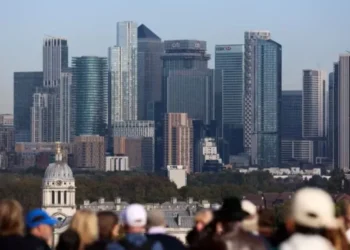Trump Says Inflation Is “Defeated” as Fed Cuts Rates Amid Ongoing Price Strain
Published: October 13, 2025, 22:45 EDT
Inflation Eases Slightly, but Prices Remain Elevated for Many Americans
U.S. President Donald Trump has declared victory over inflation, touting falling grocery and mortgage costs, even as government data shows prices remain stubbornly high for millions of Americans. Despite recent rate cuts by the Federal Reserve, inflation has risen in three of the last four months and remains above the central bank’s 2% target.
At the United Nations General Assembly last month, Trump said, “Grocery prices are down, mortgage rates are down, and inflation has been defeated.” But Federal Reserve data and consumer surveys suggest a more complex picture — one that continues to challenge households and policymakers alike.
The Fed’s Balancing Act Between Inflation and Growth
Federal Reserve Chair Jerome Powell, in a high-profile August address, said inflation “has come down a great deal” from its post-pandemic highs, while acknowledging it remains “somewhat elevated.” Shortly afterward, the Fed cut its key interest rate for the first time this year.
The move reflected confidence that the Trump administration’s tariff measures would cause only temporary price increases. Yet, economists warn that if inflation remains persistent, the central bank’s credibility in managing price stability could suffer.
“The Fed is taking a calculated risk,” said Karen Dynan, senior fellow at the Peterson Institute for International Economics. “If inflation doesn’t ease as expected, these rate cuts could be viewed as a mistake in hindsight.”
Tariffs Add Pressure to Consumer Prices
Trump’s recent wave of tariffs has added to inflationary pressures in several sectors. Tariffs on steel, aluminum, and consumer goods have raised production costs, forcing many U.S. companies to pass on expenses to consumers.
In August, consumer prices rose 2.9% year over year, compared with 2.6% a year earlier. The cost of durable goods such as furniture and appliances increased nearly 2%, reversing a decades-long trend of falling prices. Grocery costs climbed 2.7%, while coffee prices surged 21%, driven by a 50% import tax on Brazilian beans and climate-related crop losses.
“These tariffs are hitting everyday goods,” said Jason Furman, a Harvard economist and former adviser to President Barack Obama. “It’s a big gamble to assume these effects will be transitory.”
Businesses Struggle to Absorb Rising Costs
For many manufacturers and retailers, the tariffs are forcing tough choices. Chris Butler, CEO of National Tree Company, said his business plans to raise prices by about 10% this holiday season to offset higher import costs on artificial Christmas trees and decorations.
“About 45% of our products come from China,” Butler said. “We’ve tried to get suppliers to share the cost burden, but we can’t absorb all of it.”
Tariffs as high as 145% earlier this year halted production in China, creating shortages in seasonal products. Although the duties have since been reduced, Butler said factories are still recovering, likely leading to higher prices through the end of the year.
Other companies, such as Campbell Soup Co., report similar pressures. The company’s CEO said in September it would implement “surgical pricing initiatives” to offset tariff-related increases in steel and aluminum costs.
Economists Warn of Risks to Confidence and Stability
While overall inflation has cooled from its 9.1% peak three years ago, many Americans remain frustrated by elevated prices on essentials such as food, housing, and fuel. Economists caution that confidence in the Federal Reserve’s inflation management is vital to preventing further instability.
“If consumers and businesses stop believing inflation will stay low, it becomes self-fulfilling,” Dynan said. “People demand higher wages, companies raise prices, and it snowballs.”
Jeffrey Schmid, president of the Federal Reserve Bank of Kansas City, warned that inflation driven by eroding public confidence is harder to control than inflation caused by supply shocks. “The Fed must maintain its credibility,” he said. “Not all inflations are equally costly to fight.”
Mixed Outlook as Fed and White House Diverge
Despite criticism, some officials within the Trump administration and the Fed remain optimistic. Stephen Miran, a Fed governor appointed by Trump, said falling rental prices and reduced immigration will likely cool inflation in coming months by easing demand pressures.
“I’m more sanguine about the inflation outlook than many others,” Miran said.
Still, with new tariffs—including 100% duties on pharmaceuticals, 50% on cabinetry, and 25% on heavy trucks—looming over global supply chains, analysts say the administration’s optimism could face fresh tests before the year’s end.
The next inflation report, delayed by the ongoing government shutdown, will offer the clearest indication yet of whether inflation is finally under control—or still simmering beneath the surface.
This article was rewritten by JournosNews.com based on verified reporting from trusted sources. The content has been independently reviewed, fact-checked, and edited for accuracy, neutrality, tone, and global readability in accordance with Google News and AdSense standards.
All opinions, quotes, or statements from contributors, experts, or sourced organizations do not necessarily reflect the views of JournosNews.com. JournosNews.com maintains full editorial independence from any external funders, sponsors, or organizations.
Stay informed with JournosNews.com — your trusted source for verified global reporting and in-depth analysis. Follow us on Google News, BlueSky, and X for real-time updates.














